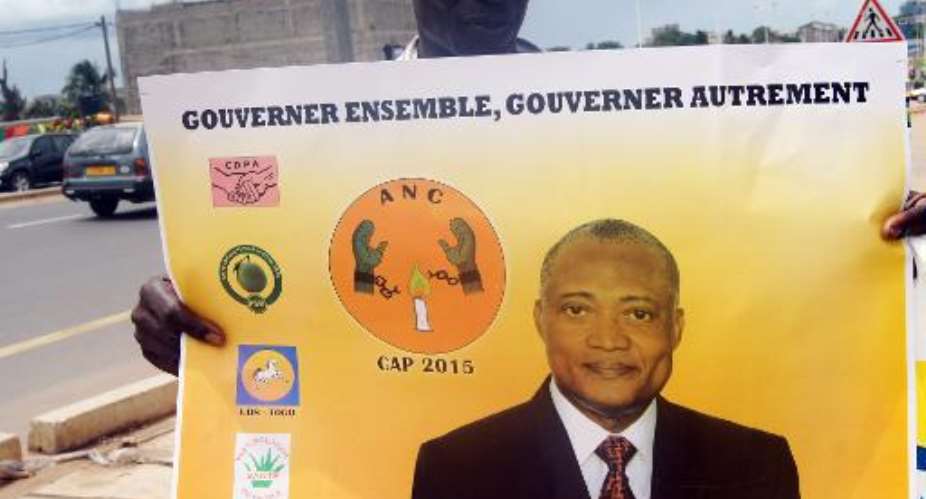Lome (AFP) - Togo elects a new president on Saturday, with the main opposition leader Jean-Pierre Fabre seeking to end nearly 50 years of rule by the Gnassingbe family.
The election in the tiny West African country takes place in a context of change in the region, after a popular uprising ousted neighbouring Burkina Faso's Blaise Compaore last year and Muhammadu Buhari's recent win in Nigeria.
Compaore was unseated after he tried to extend his 27-year hold on power while Buhari secured the first opposition presidential election victory in Nigeria's history last month.
Some 3.5 million voters will decide whether to follow suit and elect Fabre or stick with Faure Gnassingbe, whose 10 years in power follows 38 by his late father, General Gnassingbe Eyadema.
No polls or surveys exist to predict the election outcome.
But diplomats, politicians and members of civil society told AFP the result could be closer than during the last election in 2010.
Gnassingbe remains the favourite to win a third term in power but Fabre, leader of the main opposition Combat for Political Change (CAP) coalition, has gained ground.
"We are pleasantly surprised by the calm of the campaign but (the gap) has narrowed. Fabre can win," said one Western diplomat.
Even those in power are not ruling out the opposition's chances.
"It could shift. I would say that Faure has a 75 percent chance of winning and Fabre 25 percent," said one government minister.
In 2010, Gnassingbe won 60.81 percent of the vote against 33.93 percent for Fabre -- results that were contested by the opposition.
But the international community judged the outcome "acceptable" as opposed to the 2005 election which was marred by fraud and violence resulting in between 400 and 500 deaths, according to the United Nations.
- Inequality -
The west African regional bloc ECOWAS, the African Union and local civil society groups will have election observers monitoring the Togo poll.
Some 9,000 police will also be deployed to oversee security throughout the day.
This year's election, which was initially scheduled for April 15, was postponed by 10 days over claims the voter register was flawed.
The International Organisation of La Francophonie announced last week that the problems had been resolved and the opposition was satisfied with the changes.
The build-up to the election was dominated by opposition attempts to have the number of terms a president can serve limited to two, which would have ruled Gnassingbe out of the running.
Their efforts were blocked in parliament, where Gnassingbe's party has a majority.
Late last year, opposition supporters also took to the streets with civil society groups to demand reforms.
Fabre has promised that if elected, he will put an end to impunity, corruption and "repeated violations of the constitution and laws".
Gnassingbe, in this week's Jeune Afrique weekly newspaper, asked to be judged on his economic performance.
Togo's GDP has more than doubled since 2005, with economic growth reaching 5.6 percent in 2014.
The president has also launched major infrastructure projects, including the construction of new roads across the country.
But "the roads can't be eaten", said Aime, a taxi driver in Togo's capital Lome, while expressing satisfaction with the roadway improvements.
The opposition says that the majority of the country's seven million people are still awaiting tangible benefits of economic growth.
The United Nations Development Programme says the rich have benefitted more than the poor.
Latest figures show that in 2011, more than 58 percent of Togolese lived on less than a dollar a day. By the government's own admission, the situation has only slightly improved since then.





 We’ll no longer tolerate your empty, unwarranted attacks – TUC blasts Prof Adei
We’ll no longer tolerate your empty, unwarranted attacks – TUC blasts Prof Adei
 Bawumia donates GHc200,000 to support Madina fire victims
Bawumia donates GHc200,000 to support Madina fire victims
 IMF to disburse US$360million third tranche to Ghana without creditors MoU
IMF to disburse US$360million third tranche to Ghana without creditors MoU
 Truck owner share insights into train collision incident
Truck owner share insights into train collision incident
 Paramount chief of Bassare Traditional Area passes on
Paramount chief of Bassare Traditional Area passes on
 Two teachers in court over alleged illegal possession of BECE papers
Two teachers in court over alleged illegal possession of BECE papers
 Sunyani: Victim allegedly shot by traditional warriors appeals for justice
Sunyani: Victim allegedly shot by traditional warriors appeals for justice
 Mahama vows to scrap teacher licensure exams, review Free SHS policy
Mahama vows to scrap teacher licensure exams, review Free SHS policy
 Government will replace burnt Madina shops with a new three-story, 120-store fac...
Government will replace burnt Madina shops with a new three-story, 120-store fac...
